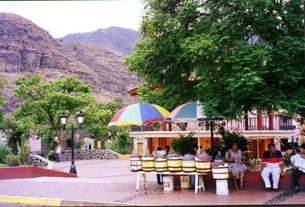I reviewed Chandos’s other book, “House in the Sun”, in MexConnect a couple of months ago and now I’m catching up on what was actually the author’s first book, published four years earlier. The later book covered his life in Ajijic, running a bed & breakfast and dealing with a mixed bag of visitors, as well as the locals back in the 1940s. This earlier account covers his initial arrival in Ajijic and his adventures in getting to know the place and the people. Not much is said about his background but he sounds like an almost complete stranger to Mexico. In any event, we’re given a good account of his decision to build a house by the lake and get settled here.
The narrative covers his first twelve months in the village and all that happened in that period. The major event was the decision to build the house and the various processes involved in making a deal for a plot of land and then hiring workmen. At the same time, we meet a lot of locals who either work for Chandos or were involved in the subsequent construction of the house. Also, along the way, we’re given a good long loving look at the various events that mark a typical year in a Mexican village – like The Day of the Dead, the Day of the Cross, Navidad, birthdays and the other festivals that are customarily celebrated. It all adds up to an attractive narrative.
One really disturbing element for this reader is the frequent mention of Lake Chapala itself. The lake obviously played a huge part in the lives of these people. The villagers fished it and seemed to get substantial catches. Obviously there were a lot more boats out there and it was a much more lively and attractive place than it is today. The locals bathed in the lake, they washed their clothes in it and they played in it. The highway to Chapala and Jocotopec didn’t provide a very comfortable ride for automobiles and, as Chandos states: “It was an anti-climax to approach Ajijic by road and I always tried to arrange for newcomers to arrive by water.” One of the larger boats even carried a group of musicians aboard. One simply can’t imagine that happening today, given the Lake’s deplorable state. (Editor’s Note: As of 2009, Lake Chapala has fully recovered and is in good health).
Apart from the frequent mentions of life on the lake we’re given copious descriptions of the author’s adjustment to the people and customs of Ajijic. He hires servants for his house and has an occasionally frustrating time teaching them things like how to set the table properly and how to serve a meal. He also learns how to deal with scorpions and other insect life and meets up with new food items – papayas, avocados and mangoes. Evidently Ajijic was famous for its mangoes at that time. It was also a famous peanut-growing place. Chandos talks about peanuts growing everywhere.
He’s obviously quite taken with the local scenery and there are many wonderful descriptions of the lake and the mountains and gardens and sunsets. Indeed, the real strength of this tale is that the author loves the place and he’s so observant regarding everything that’s going on around him.
As he points out: “In Mexico you are never out of sight of a mountain or a burro.” But even then, things were changing because he later states: “There isn’t a young man in the village who wouldn’t prefer a bicycle to a horse any day.” Bikes cost less, which was one attractive feature. Also, you didn’t have to feed them. Even then, however, there were only two or three bikes in the entire village.
If I have a problem or a criticism of this book it’s that the author is so anonymous – mysterious, in fact. I realize that Dane Chandos is not an actual person. Rather, he’s two authors – Peter Lilly and Anthony Stansfeld. Lilly is the one who built the house that became a bed & breakfast. He lived in Ajijic for forty years and seems to be the one who lived the experiences described in the books. Stansfeld was a professor of art history and a frequent visitor who collaborated on the book. But, still, you’re never quite sure who the author of this narrative actually is. He’s just too anonymous. He just suddenly appears in Ajijic. We don’t know where he came from or why he came. We are never told why he is in Mexico or if he has been to other parts of the country or, for that matter, what brought him to Ajijic. There’s precisely one mention of him being a writer but we never know what he’s supposed to be writing or what he may have written in the past. We know absolutely nothing of his life. Guests and visitors arrive – from France, England, Germany and elsewhere – and he evidently knows many of them from another life but we’re given no details.
This author anonymity isn’t a huge flaw but for this reviewer it did become a bit of an irritant at times. Everything takes place in a kind of eternal “present”. However, the real subject of this story is the village of Ajijic itself. And this is a good description of the way it used to be.
In my humble O: A mildly interesting story for today’s readers.
Sometimes available from Amazon Books: Paperback

